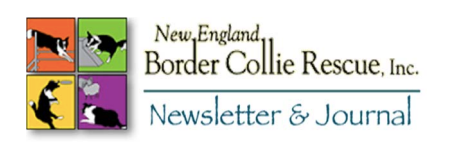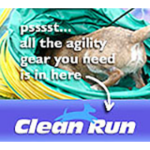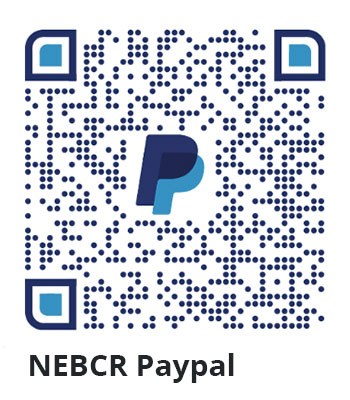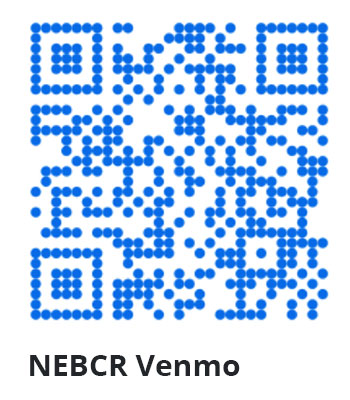Newsletter & Journal 2.2
VOLUME II NUMBER 2
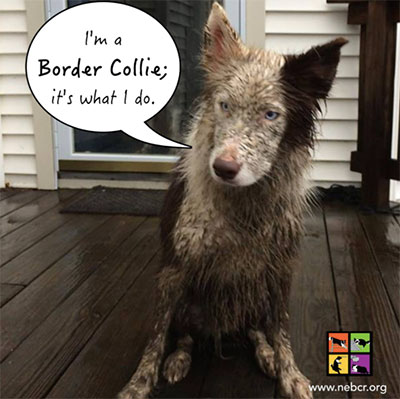
Co-Presidents: Bea Hamm & Sarah Hepburn
Treasurer: Mo Clark
Secretary: Emily Wu
Board of Directors: Monique Fisher, Elise Gouge, Marie Hinds
Website: Rebeca Kerr & Monique Fisher
Editors: Bea Hamm & Rebeca Kerr
Please send your content and pictures to us at: [email protected]
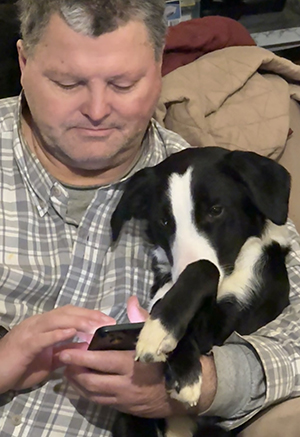
Featured:
Jackpot is checking out his bio and can’t understand why he hasn’t been snatched up yet.
You’ll find his full bio here.
Introducing Volunteer Member Kelly Pontbriand
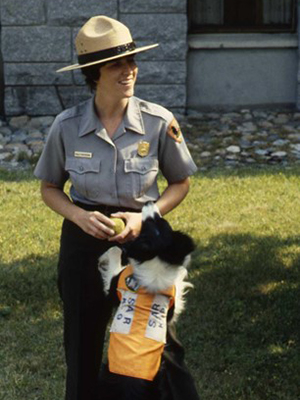
I became interested in training a dog for search and rescue work in 1985. My husband and I were National Park Service rangers and our work often involved searching for lost hikers. When I decided to start training my own search and rescue dog, I chose a Labrador retriever. At that time, the majority of search dogs in the United States were German shepherd dogs, Labrador retrievers, and golden retrievers.
After a lack of success in training the lab for search work, I attended several search dog seminars and talked to numerous search dog handlers. One handler from California said that he was thinking of trying a border collie for search work. That’s when I began to consider finding a border collie for my next search dog.
When I began my pre-internet search for handlers who were using border collies for search work, I only found two people in the United States. The owner of one of these dogs offered to send me the pick of a litter sired by her border collie search dog. A few weeks later, a small black and white female BC was shipped from Memphis, Tennessee to Bangor, Maine. “Sweep” immediately began her training for search work.
Many expressed doubts when they first saw me in the field with this petite 32-pound border collie. On her first mission, Sweep found an important piece of evidence in a search for a lost woman in the forest along the border of Maine and Canada. Doubts were soon erased as her career progressed and she made several life-saving finds. Other handlers began to consider the border collie as their next search dog after watching Sweep do her work.
Since that time, I have trained, certified, and partnered with five other wonderful border collies for search and rescue work. We have assisted with searches for lost people in Maine, New Hampshire, Vermont, South Dakota, Wyoming, Nebraska, Colorado, Utah, and Washington. We have descended into caves, climbed mountains, flown in helicopters, rafted through rapids, and encountered bears, bison, and rattlesnakes along the way.
When our careers brought us to Maine’s Acadia National Park in 2002, I learned about New England Border Collie Rescue. I fostered my first NEBCR dog in 2005 and have fostered eight dogs since that time and adopted one NEBCR dog. I always hoped that one of my foster dogs would become one of my search and rescue partners, but ages and temperaments never aligned at the right time for this to happen.
I can’t imagine my life without a border collie. Volunteering for NEBCR is my way of giving back to the wonderful border collie breed. I still foster on occasion, help with the intake spreadsheet, and send out NEBCR calendars. I am honored to be part of this network of wonderful people who do so much to help this wonderful breed.
So, You Think You Want a Border Collie?
by Kerry Maloney
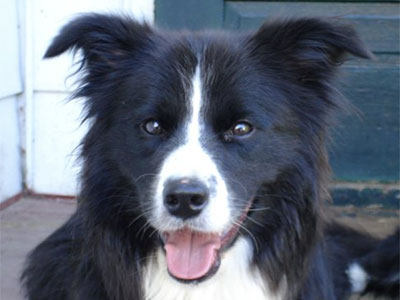
I grew up around animals of all sorts – dogs, cats, chickens, turkeys, crows…all were pets of mine at some point. I spent a good part of my childhood playing with and training dogs. I had my coonhound trained to follow all sorts of verbal and hand signals, do all sorts of tricks, even climb up – but not down – ladders. My father was less than amused when, after doing some roofing work one weekend and forgetting to put the ladder away, he came home from work on Monday to see a 75-pound coonhound up on the roof, sunbathing with our cat. My mother thought it was hilarious and said maybe now he would learn to put his tools away when he was done with a project. (Spoiler alert: he didn’t.)
All of this is a long way of saying I knew dogs. Or I thought I did…until I decided to enter the world of border collies.
Fast forward to moving into my first house and immediately getting my first dog on my own – Dublin, a male border collie puppy. I had wanted a border collie for years, but waited until I had a house with a yard. And as much experience as I had with dogs, I had never lived with one in the house as my parents were of the belief that animals “did not belong in the house”. So, I had to train my BC in all the things he needed to know to live in the house. But border collies are smart dogs, so this should be a piece of cake, right? Even easier than with your average dog, right?
Ah, the misconceptions of the newbie border collie owner….
Of course, I made all the newbie mistakes. The first time I left Dublin free from the crate during a one-hour errand, just to see how he would do, was also the one time I completely forgot that I had a pound of cooked ground beef cooling on the counter. I came home to find a perfectly clean plate on the kitchen floor, and I didn’t know why until it dawned on me that plate had been holding the beef and I had just effectively trained my dog to counter-surf. The thing about smart dogs? They only need one time to lock something in and a pound of ground beef was a high reward. Dublin was a phenomenal dog – in later years, he was my demo dog when I taught training classes – but he was a counter-surfer until the day he died.
But the true “aha” moment I had as a newbie border collie owner came a few months later. This is the moment I always think about, decades later, when someone asks me what they need to prepare for a border collie and I answer, “a good sense of humor and a willingness to laugh at yourself”.
Dublin had graduated to being free in the house without any accidents, but he had started getting into the garbage. Unfortunately, I allowed it to happen a couple times and, as you know, it only takes one or two times for a border collie to learn a habit and then I was stuck with a border collie regularly getting into the garbage. I had already begun to accept that I was going to be stuck with the counter surfing, so I wanted to remove his access to the garbage before this, too, became a permanent habit. I did some research, and my solution was to buy a different garbage can that I spent way too much money on. But it was a fancy-schmancy, weighted garbage can with a pedal mechanism that I just knew was going to fix this problem. The garbage can arrived, I read the instructions – because, yes, it actually had instructions on how to set it up – I figured out how to attach everything so the garbage and the bag were completely contained within the cylinder and Dublin couldn’t get to it. I attached the weighted lid and pedal mechanism, and we were good to go. Dublin was watching me the entire time, probably wondering what new game this was. I set it up in its spot, stepped on the pedal, the lid opened, I threw out some of the plastic packaging and I stepped back and the weighted lid came down with a satisfying “thump”, sealing the garbage from Dublin. Dublin walked over to the can, stepped on the pedal, raised the lid, looked into the garbage can, stepped back and let the lid thump down and looked at me like “okay, I can work with this” and walked into the other room.
This was the moment when I realized I may have bitten off more than I could chew with my new border collie and my real learning began. Twenty years later and it hasn’t stopped…
What’s Up?
For the past few years NEBCR has been invited to attend the Highland Games at Thomas Point, Brunswick, Maine. We have a booth selling items mostly made by our volunteers, provide demos, answer questions about the adoption process and the breed in general. This year the date will be August 17th. If you attend please stop by. Here is a video of last years Highland Games
And for the first time this year we will be adding Highland Games at the Fort #4 Charlestown, NH on June 29th. We are all looking forward to expanding our efforts to share our knowledge of the breed.
Any volunteers, past or present adopters from NEBCR will want to mark their calendars for the NEBCR Reunion. It will be held on August 10th at Sugar Bush Farm in Stephentown, NY. Always a great time with demos, a chance to catch up and a huge raffle too. This event is not open to the general public only those directly involved with NEBCR through volunteering or adopting through NEBCR. Details will be posted in our next newsletter.
ASK THE VET: Hot Spots/Summer Itch
by Dr Sarah Hepburn
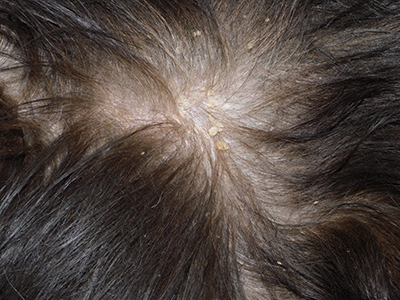
The rising temperatures of summer and increased outdoor activities also bring about a higher risk of skin issues in dogs. Hot spots and summer skin diseases can quickly become so vigilance and proactive measures are necessary to keep our furry friends happy and healthy.
One of the common skin problems dogs face during the summer months is hot spots, medically known as acute moist dermatitis. Hot spots are localized areas of inflammation and infection that often manifest as red, moist, and irritated lesions on a dog’s skin. These spots can appear suddenly and progress rapidly, leading to discomfort and incessant itching for the afflicted pooch. Common causes include excessive licking, scratching, or biting, often triggered by allergies, insect bites, scratching at ears if there is underlying ear infection, damp collars holding moisture against the skin, or lingering moisture on the fur after a swim.
Preventing hot spots involves regular grooming and maintaining good hygiene practices for your canine companion. Regular brushing helps remove loose hair and reduces the chances of matting, which can trap moisture close to the skin. Ensure your dog is thoroughly dried after a swim or bath, paying special attention to areas prone to hot spots. Additionally, addressing any underlying allergies or sensitivities through a balanced diet and consulting with a veterinarian can be crucial in preventing these irritating skin issues.
Apart from hot spots, summer also brings about an increased risk of other skin diseases in dogs, such as flea and tick infestations. These pesky parasites thrive in warm, humid conditions and can lead to severe skin irritation, allergic reactions, and even transmit diseases. Regularly check your dog for signs of fleas and ticks, especially after outdoor activities, and invest in effective preventive measures such as flea and tick collars, topical treatments, or oral medications recommended by your veterinarian.
To protect your dog from sunburn, especially for those with light-colored or thin fur, consider using pet-friendly sunscreens on exposed areas, such as the nose and ears. Dogs, like humans, can suffer from sunburn, which may lead to painful blisters and increased susceptibility to skin cancers.
In conclusion, while summer promises endless outdoor adventures with our furry companions, it also brings specific challenges for their skin health. Proactive grooming, diligent hygiene practices, and preventive measures against parasites are crucial in keeping hot spots and other summer skin diseases at bay. By staying vigilant and taking these precautions, you can ensure your dog’s skin stays healthy, allowing them to enjoy the sunshine safely.
Trainer’s Corner:
Thirty Seconds to Perfect Behavior
by Elise Gouge, CPDT, CABC Certified Behavior Consultant & Trainer
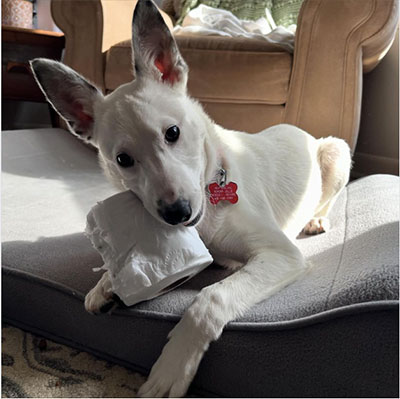
Spring is almost here and most people are waffling somewhere between excitement about warmer weather and stress about taxes and the dreary days of early spring. It’s not really the time of year that we are all thinking, hey, let’s train the dog! At the same time, with spring comes the promise of outside walks, adventures over the summer, beach trips, cookouts and lots of activities we’d love to have a well-behaved dog attend. Folks, it’s time to train the dog.
I’m here to tell you that it’s not as bad as you think. It won’t be horribly hard or time-consuming or awful to train your dog and/or repair whatever might be broken. In fact, you probably know a lot already and just have to figure out where and how to apply it.
When I do consultations, I hear these statements almost every time:
“Wow, I never thought about it that way. Makes so much sense.”
“Oh, I can totally do that!”
“Just like kids. I get it.”
Now, obviously, not every behavior and training issue is easy breezy but, in truth, many actually are kind of easy. Dog training can be amazingly complicated, artful and dynamic but at the end of the day it’s still not rocket science, folks.
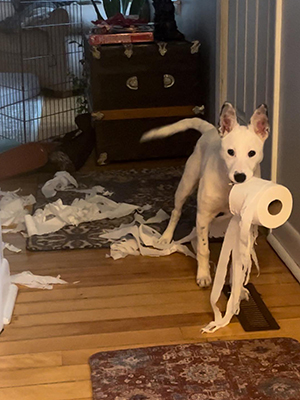
Today I am going to give you one exercise to do that can change everything. It can improve your relationship with your dog, improve his general behavior, improve his training and actually, practically, make a difference on a daily basis.
Are you ready? You will need the following items: your dog, a house with stuff in it, and you. Got all that? If you want to get fancy you can add in some rewards for your dog like toys or food but you don’t have to. Seriously, it’s that easy.
OK, so now I want you to think back to Dog Training 101 and the Leave It exercise. You probably used a treat, either in your hand or on the floor and rewarded your dog after he successfully left it alone. Don’t remember or never went to Dog Training 101? No worries. It takes 2 minutes to learn how to do this. There are a few different versions out there – Doggy Zen, Susan Garrett’s It’s Yer Choice, or Sophia Yin’s Leave It. They are all basically the same thing – impulse control games.
So much training falls to the wayside because owners don’t find it practically useful. Who cares if a dog can leave a treat alone in your hand? Who cares if he can stay while you walk around him in a circle? I get it. Being able to do tricks and/or be a superstar in class isn’t helpful when the real issue is that he’s stealing food off the counter, digging around in the trash and jumping on visitors so crazily you are speechless with embarrassment (not to mention out of breath from pulling him off).
You can make major progress on fixing those issues with this exercise. No kidding!
Go in the kitchen and make yourself a snack while thinking how silly I must be to make such a suggestion. As you’re prepping your food, drop a piece on the ground*. When your dog dives for it, block him just like you learned to do with Leave It. You might have to block, unblock, block, unblock a few times but he’ll figure out he can’t eat that piece of dropped food. He’ll figure out that, hey, this is just like that training game from class! When you see that little light-bulb go off, tell him he’s an amazing boy and pet him in his favorite spot. Make a big deal about how awesome he is and mean it.
You’re on your way. Now, take out the trash. Maybe drop a McDonald’s wrapper or delicious used tissue. See your dog creeping up to steal this lucky stash? Block him. Don’t talk, don’t boss him around and certainly don’t scold him. Just block. Unblock. When you see him back off and look at you knowingly with his “I’m leaving it alone” look, giggle with delight and give him a little party of pets and compliments.
Is it beginning to make sense? I want you to start practicing impulse control during your day. Thirty seconds here, fifteen seconds there, using whatever stuff is already in your house. Reward your dog with the fact that you honestly think he’s freakin’ amazing when you can drop a piece of sausage on the floor and he stands there and looks at you patiently. I mean, make your dog feel really good about it. Sincerity is key. If you don’t have that, you can use some food as a reward or maybe play a game with him like fetch or tug.
Keep playing the game using everything you have in the house. Stinky shoes from soccer practice, dirty diapers, underwear, glasses, remote controls, Chinese food containers, [empty] prescription pill bottles. Instead of getting frustrated and trying to keep everything away from your dog, use it all for practice. Watch your dog get more and more thoughtful, biddable and happy. Watch yourself get more and more excited about training because it works and it’s not hard and, heck, it’s even fun. Watch as your guests start to comment about what a good dog you have.
Soon, whether it’s a hot dog dropped during a cookout, a softball knocked out of the field and into your dog’s lap, or whatever it may be – your dog will handle it like a pro and both of you will be so excited to enjoy all the summer has to offer.
*If your dog becomes aggressive over food or certain items, do not practice with those. Get professional advice and never put yourself or your dog in an unsafe situation.
